What Is The Structural Makeup Of A Mobile Home
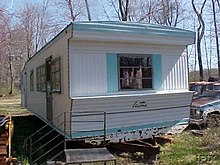
Typical mobile habitation from the late 1960s and early on 1970s: 12 by 60 anxiety (3.6 × xviii.iii m)

1958 photo of Zimmer trailer in a trailer park in Tampa Florida, this area is now a gated community with new houses
A mobile domicile (too known as a firm trailer, park home, trailer, or trailer dwelling house) is a prefabricated structure, congenital in a factory on a permanently fastened chassis before being transported to site (either by existence towed or on a trailer). Used as permanent homes, or for holiday or temporary accommodation, they are frequently left permanently or semi-permanently in 1 place, but can be moved, and may be required to move from time to time for legal reasons.
Mobile homes share the aforementioned historic origins as travel trailers, but today the two are very unlike and furnishings, with travel trailers being used primarily as temporary or vacation homes. Behind the cosmetic work fitted at installation to hibernate the base, at that place are strong trailer frames, axles, wheels, and tow-hitches.
History [edit]
In the United States, this form of housing goes back to the early years of cars and motorized highway travel.[1] It was derived from the travel trailer (oft referred to during the early on years every bit "firm trailers" or "trailer coaches"), a small unit with wheels attached permanently, often used for camping or extended travel. The original rationale for this type of housing was its mobility. Units were initially marketed primarily to people whose lifestyle required mobility. However, in the 1950s, the homes began to be marketed primarily every bit an inexpensive course of housing designed to be set up upwardly and left in a location for long periods of fourth dimension or even permanently installed with a masonry foundation. Previously, units had been eight anxiety or fewer in width, but in 1956, the 10-foot (3 m) wide home ("ten-wide") was introduced, along with the new term "mobile home".[2]
The homes were given a rectangular shape, made from pre-painted aluminum panels, rather than the streamlined shape of travel trailers, which were usually painted afterward associates. All of this helped increase the divergence between these homes and home/travel trailers. The smaller, "eight-wide" units could be moved but with a automobile, merely the larger, wider units ("ten-wide", and, subsequently, "twelve-wide") ordinarily required the services of a professional trucking company, and, often, a special moving permit from a state highway department. During the late 1960s and early on 1970s, the homes were made even longer and wider, making the mobility of the units more difficult. Nowadays, when a factory-built home is moved to a location, it is usually kept in that location permanently and the mobility of the units has considerably decreased. In some states, mobile homes take been taxed as personal property if the wheels remain attached, but as real estate, if the wheels are removed. Removal of the tongue and axles may too be a requirement for real estate classification.
Manufactured domicile [edit]

Mobile homes built in the The states since June 1976, legally referred to as manufactured homes, are required to encounter FHA certification requirements and come up with attached metal certification tags. Mobile homes permanently installed on endemic land are rarely mortgageable, whereas FHA code manufactured homes are mortgageable through VA, FHA, and Fannie Mae.
Many people who could not beget a traditional site-built domicile, or did non desire to commit to spending a large sum of money on housing, began to see factory-built homes as a viable alternative for long-term housing needs. The units were often marketed as an alternative to apartment rental. Notwithstanding, the tendency of the units of this era to depreciate apace in resale value[ citation needed ] made using them equally collateral for loans much riskier than traditional home loans. Terms were ordinarily limited to less than the thirty-year term typical of the general home-loan market, and interest rates were considerably higher.[ citation needed ] In that fashion, mobile domicile loans resembled motor vehicle loans more than than traditional abode mortgage loans.
Construction and sizes [edit]
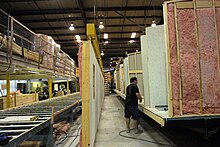
Exterior wall assemblies being set in place during industry
Mobile homes come in two major sizes, single-wides and double-wides. Unmarried-wides are 18 anxiety (5.5 m) or less in width and 90 feet (27 one thousand) or less in length and can exist towed to their site as a single unit of measurement. Double-wides are 20 anxiety (6.1 k) or more than wide and are 90 feet (27 m) in length or less and are towed to their site in two separate units, which are so joined together. Triple-wides and even homes with 4, v, or more units are also built but less frequently.
While site-congenital homes are rarely moved, single-wide owners often "trade" or sell their home to a dealer in the form of the reduction of the buy of a new dwelling. These "used" homes are either re-sold to new owners or to park owners who use them equally inexpensive rental units. Single-wides are more than probable to exist traded than double-wides considering removing them from the site is easier. In fact, only about v% of all double-wides will always exist moved.[ citation needed ]
While an EF1 tornado might cause minor harm to a site-built abode, information technology could do pregnant damage to a manufacturing plant-built domicile, especially an older model or one that is not properly secured. Also, structural components (such as windows) are typically weaker than those in site-congenital homes.[3] 70 miles per hr (113 kilometers per hr) winds can destroy a mobile dwelling in a affair of minutes. Many brands offer optional hurricane straps, which tin exist used to tie the dwelling to anchors embedded in the ground.
Regulations [edit]
United States [edit]
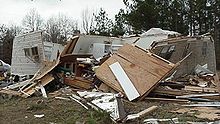
Domicile struck by F2 tornado
In the Usa, mobile homes are regulated by the US Department of Housing and Urban Evolution (HUD), via the Federal National Manufactured Housing Structure and Safety Standards Act of 1974. This national regulation has allowed many manufacturers to distribute nationwide considering they are immune to the jurisdiction of local edifice authorities.[iv] [5] :1 Past dissimilarity, producers of modular homes must abide by country and local edifice codes. There are, however, wind zones adopted past HUD that home builders must follow. For example, statewide, Florida is at to the lowest degree windzone two. Southward Florida is windzone 3, the strongest wind zone. After Hurricane Andrew in 1992, new standards were adopted for dwelling house construction. The codes for edifice inside these wind zones were significantly amended, which has greatly increased their immovability. During the 2004 hurricanes in Florida, these standards were put to the exam, with great success. Yet, older models continue to face the exposed run a risk to high winds because of the attachments applied such as carports, porch and screen room additions. Such areas are exposed to "wind capture" which utilise farthermost force to the underside of the integrated roof panel systems, ripping the fasteners through the roof pan causing a series of events which destroys the main roof system and the abode.
The popularity of the manufacturing plant-congenital homes caused complications the legal arrangement was not prepared to handle. Originally, mill-built homes tended to be taxed as vehicles rather than real estate, which resulted in very low property tax rates for their inhabitants. That acquired local governments to reclassify them for taxation purposes.
However, fifty-fifty with that change, rapid depreciation ofttimes resulted in the dwelling house occupants paying far less in property taxes than had been predictable and budgeted. The power to move many factory-congenital homes apace into a relatively pocket-sized area resulted in strains to the infrastructure and governmental services of the affected areas, such equally inadequate water pressure and sewage disposal, and highway congestion. That led jurisdictions to begin placing limitations on the size and density of developments.
Early homes, even those that were well-maintained, tended to depreciate over time, much like motor vehicles. That is in dissimilarity to site-built homes which include the land they are built on and tend to appreciate in value. The arrival of mobile homes in an area tended to be regarded with alarm, in function because of the devaluation of the housing potentially spreading to preexisting structures.
This combination of factors has acquired nearly jurisdictions to place zoning regulations on the areas in which manufacturing plant-built homes are placed, and limitations on the number and density of homes permitted on any given site. Other restrictions, such as minimum size requirements, limitations on outside colors and finishes, and foundation mandates take also been enacted. There are many jurisdictions that volition non allow the placement of any additional factory-congenital homes. Others have strongly limited or forbidden all single-wide models, which tend to depreciate more rapidly than modern double-wide models.
Apart from all the practical issues described above, in that location is also the abiding discussion about legal fixture and chattels and so the legal status of a trailer is or could be affected past its incorporation to the land or not. This sometimes involves such factors as whether or not the wheels have been removed.
Cleveland, Mississippi [edit]
The city of Cleveland, Mississippi, has made efforts to eliminate its "run-down mobile homes," which the city describes as "unsightly."[6]
North Carolina [edit]
The Due north Carolina Lath of Transportation allowed 14-pes-wide homes on the state's roads, but until January 1997, 16-foot-wide homes were non allowed. 41 states allowed 16-foot-side homes, but they were not sold in Due north Carolina. Under a trial program approved January 10, 1997, the wider homes could be delivered on specific roads at certain times of twenty-four hour period and travel 10 mph below the speed limit, with escort vehicles in forepart and behind.[vii] [eight] Eventually, all homes had to leave the state on interstate highways.[nine]
In December 1997, a study showed that the wider homes could be delivered safely, but some opponents still wanted the program to end.[ten] On Dec ii, 1999, the NC Manufactured Housing Institute asked the country Board of Transportation to aggrandize the program to allow deliveries of 16-human foot-wide homes inside Due north Carolina.[9] A month subsequently, the board extended the pilot plan by iii months but did not vote to allow shipments within the state.[xi] In June 2000, the lath voted to allow xvi-foot-side homes to exist shipped to other states on more two-lane roads, and to allow shipments in the state east of US 220. A tertiary escort was required, including a law enforcement officer on 2-lane roads.[12]
New York [edit]
In New York Country, the Homes and Community Renewal agency tracks mobile home parks and provides regulations concerning them. For example, the agency requires park owners to provide residents with a $15,000 grant if residents are forced to move when the land is transferred to a new possessor. Residents are also granted the right of first refusal for a sale of the park, however, if the owner does not evict tenants for five years, the state auction can go ahead. State police likewise restricts the annual increase in land lot fee to a cap of 3 percent, unless the landowner demonstrates hardship in a local courtroom, and can then raise the land lot fee by up to 6 percent in a twelvemonth.[thirteen]
Mobile home parks [edit]

Meadow Lanes Estates Mobile Domicile Park, Ames, Iowa, August 2010, during a overflowing
Mobile homes are oftentimes sited in state lease communities known as trailer parks (also 'trailer courts', 'mobile home parks', 'mobile home communities', 'manufactured dwelling communities', 'manufacturing plant-congenital abode communities' etc.); these communities allow homeowners to rent infinite on which to place a habitation. In addition to providing space, the site oft provides basic utilities such as water, sewer, electricity, or natural gas and other civilities such equally mowing, garbage removal, community rooms, pools, and playgrounds.
There are over 38,000[14] trailer parks in the The states ranging in size from 5 to over 1,000 domicile sites. Although near parks entreatment to coming together basic housing needs, some communities specialize towards certain segments of the market. One subset of mobile domicile parks, retirement communities, restrict residents to those age 55 and older. Another subset of mobile dwelling house parks, seasonal communities, are located in popular vacation destinations or are used as a location for summer homes. In New York Land, as of 2019, in that location were 1,811 parks with 83,929 homes.[13]
Newer homes, particularly double-wides, tend to be built to much higher standards than their predecessors and meet the building codes applicable to well-nigh areas. That has led to a reduction in the rate of value depreciation of almost used units.[fifteen]
Additionally, modern homes tend to be built from materials similar to those used in site-built homes rather than junior, lighter-weight materials. They are likewise more likely to physically resemble site-built homes. Often, the master differentiation in advent is that factory-built homes tend to have less of a roof slope then that they can be readily transported underneath bridges and overpasses.[ citation needed ]
The number of double-wide units sold exceeds the number of single-wides, which is due in part to the aforementioned zoning restrictions. Another reason for college sales is the spaciousness of double-wide units, which are now comparable to site-built homes. Single-broad units are still popular primarily in rural areas, where at that place are fewer restrictions. They are oftentimes used as temporary housing in areas affected by natural disasters when restrictions are temporarily waived.[ citation needed ]
Another recent tendency has been parks in which the possessor of the mobile home owns the lot on which their unit of measurement is parked. Some of these communities merely provide country in a homogeneous neighborhood, merely others are operated more than similar condominiums with club homes complete with pond pools and meeting rooms which are shared past all of the residents, who are required to pay membership fees and ante.
By country [edit]
Mobile home (or mobile-homes) are used in many European campgrounds to refer to stock-still caravans, purpose-built cabins, and fifty-fifty large tents, which are rented by the calendar week or even year-round equally cheap accommodation, similar to the United states concept of a trailer park. Similar many other US loanwords, the term is non used widely in Britain.[ citation needed ]
Great britain [edit]

The Picket Order, a mobile home by Prestige Homeseeker, marketed as a holiday home
Mobile Homes or Static Caravans are pop across the United Kingdom. They are more commonly referred to equally Park Homes or Leisure Lodges, depending on if they are marketed as a residential home or as a 2d holiday home residence.
Residential Mobile homes (park homes) are built to the BS3632 standard. This standard is issued by the British Standards Establish. The institute is a UK body who produce a range of standards for businesses and products to ensure they are fit for purpose. The bulk of residential parks in the UK have a minimum historic period limit for their residents, and are generally marketed as retirement or semi-retirement parks. Holiday Homes, static caravans or holiday lodges aren't required to be built to BS3632 standards, but many are built to the standard.
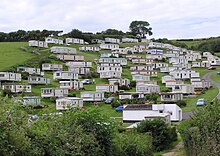
In add-on to mobile homes, static caravans are popular across the U.k.. Static caravans have wheels and a rudimentary chassis with no suspension or brakes and are therefore transported on the back of large flatbed lorries, the beam and wheels being used for movement to the final location when the static caravan is moved by tractor or 4x4. A static caravan commonly stays on a single plot for many years and has many of the modernistic conveniences one would normally observe in a home.
Mobile homes are designed and constructed to be transportable by road in one or two sections. Mobile homes are no larger than 20 one thousand × 6.8 m (65 ft 7 in × 22 ft 4 in) with an internal maximum superlative of 3.05 k (10 ft 0 in). Legally, mobile homes tin can still be defined as "caravans".
Static holiday caravans by and large have sleeping accommodation for 6 to ten people in ii, 3 or 4 bedrooms and on convertible seating in the lounge referred to every bit a 'pull out bed'. They tend towards a fairly "open-programme" layout, and while some units are double glazed and centrally heated for year-round use, cheaper models without double glazing or central heating are available for mainly summer utilize. Static caravan holiday homes are intended for leisure utilise and are available in 10 ft (three.0 yard) and 12 ft (iii.7 yard) widths, a small number in 13 ft (iv.0 g) and 14 ft (iv.3 chiliad) widths, and a few xvi ft (four.9 thou) wide, consisting of two 8 ft (2.four yard) wide units joined together. Generally, vacation homes are clad in painted steel panels, but can exist clad in PVC, timber or composite materials. Static caravans are sited on caravan parks where the park operator of the site leases a plot to the caravan owner. At that place are many holiday parks in the UK in which one's own static caravan can exist owned. There are a few of these parks in areas that are prone to flooding and anyone considering buying a sited static caravan needs to take particular care in checking that their site is not liable to flooding.
Static caravans can be rented on an advertising-hoc footing or purchased. Purchase prices range from £25,000 to £100,000. Once purchased, static caravans have various ongoing costs including insurance, site fees, local authorization rates, utility charges, winterisation and depreciation. Depending on the type of caravan and the park these costs can range from £1,000 to £40,000 per year.[16] Some park owners used to have unfair conditions in their charter contracts but the Part of Fair Trading has produced a guidance document available for download called Unfair Terms in Vacation Caravan Agreements which aims to terminate unfair practices. Park mobile home owner rights and obligations can be found on the U.k. government site
Israel [edit]

Many Israeli settlements and outposts are originally composed of caravans (Hebrew: קראוואן caravan; pl. קראוואנים, caravanim). They are synthetic of calorie-free metal, are not insulated only tin can be outfitted with heating and air conditioning units, h2o lines, recessed lighting, and floor tiling to role in a full-service capacity. Starting in 2005, prefabricated homes, named caravillas (Hebrew: קרווילה), a portmanteau of the words caravan, and villa, brainstorm to replace mobile homes in many Israeli settlements.
Divergence from modular homes [edit]
Considering of similarities in the manufacturing procedure, some companies build both types in their factories. Modular homes are transported on flatbed trucks rather than being towed, and lack axles and an automotive-type frame. However, some modular homes are towed backside a semi-truck or toter on a frame similar to that of a trailer. The home is usually in two pieces and is hauled past two separate trucks. Each frame has five or more than axles, depending on the size of the home. Once the home has reached its location, the axles and the tongue of the frame are so removed, and the abode is assault a concrete foundation by a large crane.
Both styles are commonly referred to as factory-built housing, but that term'due south technical use is restricted to a form of homes regulated by the Federal National Mfd. Housing Structure and Safe Standards Act of 1974.
Virtually zoning restrictions on the homes have been found to be inapplicable or only applicable to modular homes. That occurs often after considerable litigation on the topic past affected jurisdictions and past plaintiffs failing to ascertain the difference. Most modern modulars, one time fully assembled, are indistinguishable from site-built homes. Their roofs are normally transported equally dissever units. Newer modulars also come with roofs that can be raised during the setting process with cranes. There are also modulars with 2 to four storeys.
Gallery [edit]
-

Structure starts with the frame.
-

Interior wall assemblies are attached.
-

Roof assembly is set atop dwelling house.
-

Drywall is completed.
-
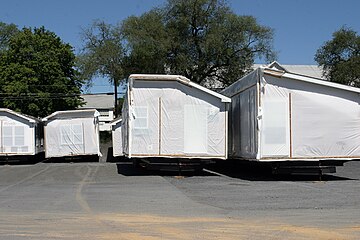
Home is gear up for delivery to site.
-
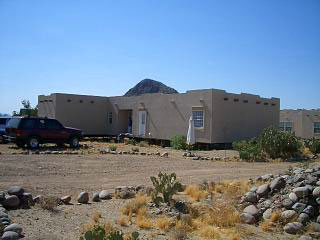
A modernistic "triple broad" abode, designed to look similar an adobe dwelling
-
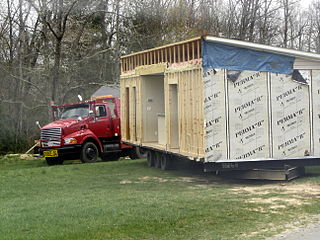
A mobile home being prepared for send
Meet as well [edit]
- All Parks Alliance for Modify
- Campervan
- Construction trailer
- Houseboat
- Manufactured housing
- Modular home
- Motorhome
- Nomadic wagons
- Recreational vehicle
- Minor house movement
- Trailer (vehicle)
- Trailer Park Boys
- Trailer trash
- Vardo
References [edit]
- ^ "Office 17, Mobile Dwelling Parks". ny.gov.
- ^ "Mobile Manufactured Homes". ct.gov . Retrieved 28 March 2018.
- ^ "Caravan Repairs? Keen Caravan Repair Deals!". canterburycaravans.com.au.
- ^ "Titles for Mobile Homes". AAA Digest of Motor Laws.
- ^ Andrews, Jeff (January 29, 2018). "HUD to explore deregulating manufactured housing". Curbed. Archived from the original on 2018-01-29. Retrieved 2019-04-19 .
- ^ Armour, Bryce (January viii, 2017). "Are Cleveland, MS Old Homes and Trailers Withal an Eyesore". EZ Homes.
- ^ Hackett, Thomas (January 11, 1997). "Actress-wide homes to take to the road". News & Observer. p. A3.
- ^ Mitchell, Kirsten B. (January 10, 1997). "Wider trailer send OK'd". Star-News. p. 1A.
- ^ a b Whitacre, Dianne (Dec ii, 1999). "Mobile-Domicile Makers Look to Squeeze on N.C. Roads". The Charlotte Observer. p. 1C.
- ^ "Study: Keep Curbs on Transporting Wide Mobile Homes". The Charlotte Observer. Dec 1, 1997. p. 4C.
- ^ Bonner, Lynn (Jan seven, 2000). "Plan for wide mobile homes extended". News & Observer. p. A3.
- ^ "Wide mobile homes given final approval". News & Observer. June 3, 2000. p. A3.
- ^ a b Liberatore, Wendy (January 23, 2022). "Saratoga County's mobile home parks - a sign of an affordable housing crisis". www.timesunion.com . Retrieved Jan 23, 2022.
- ^ "Database of Mobile Home Parks in the U.s.a.". Retrieved 2009-02-17 .
- ^ "Homes". Retrieved 2006-09-12 .
- ^ "Cost of a static caravan or lodge". StaticCaravanExpert. 28 December 2020. Retrieved 2021-03-07 .
Further reading [edit]
- Benson, J. E. (1990). Good neighbors: Ethnic relations in Garden City trailer courts. Urban Anthropology,19, 361–386.
- Burch-Brown, C. (1996). Trailers. Charlottesville: University Press of Virginia. Text past David Rigsbee.
- Geisler, C. C., & Mitsuda, H. (1987). Mobile-home growth, regulation, and bigotry in upstate New York. Rural Sociology, 52, 532–543.
- Hart, J. F., Rhodes, M. J., & Morgan, J. T. (2002). The unknown world of the mobile abode. Baltimore: Johns Hopkins University Press.
- MacTavish, Chiliad. A., & Salamon, South. (2001). Mobile abode park on the prairie: A new rural community grade. Rural Sociology, 66, 487–506.
- Moore, B. (2006). Trailer trash: The world of trailers and mobile homes in the Southwest. Laughlin: Route 66 Magazine.
- Thornburg, D. A. (1991). Galloping bungalows: The ascension and demise of the American business firm trailer. Hamden: Archon Books.
- Wallis, A. D. (1991). Wheel estate: The rise and decline of mobile homes. New York: Oxford Academy Press.
External links [edit]
- Basic United States Windzone Map, FEMA
- Regulating body in the United kingdom
- US Federal Manufactured Domicile Construction and Prophylactic Standards
- Details of Planning Permission For Mobile Homes in the U.One thousand.
What Is The Structural Makeup Of A Mobile Home,
Source: https://en.wikipedia.org/wiki/Mobile_home
Posted by: novathak1976.blogspot.com


0 Response to "What Is The Structural Makeup Of A Mobile Home"
Post a Comment